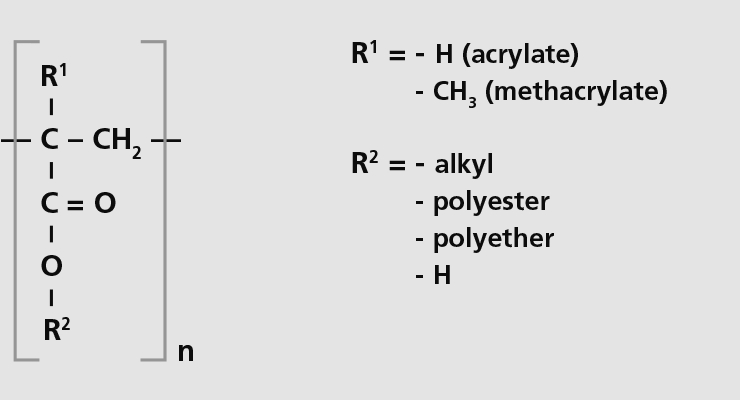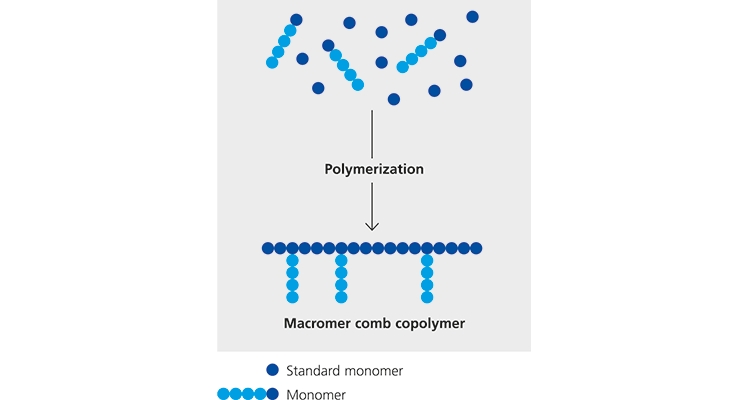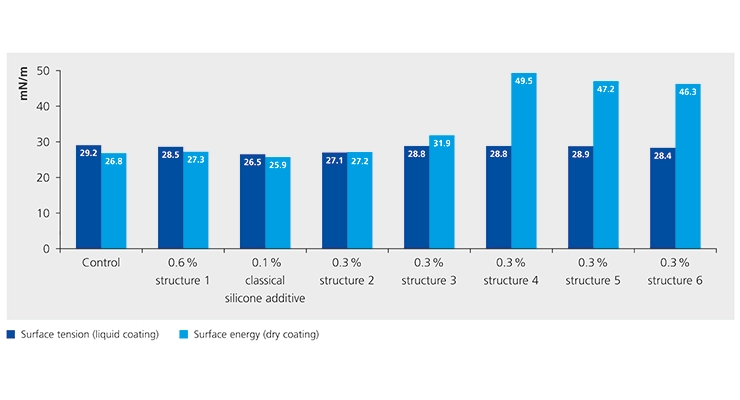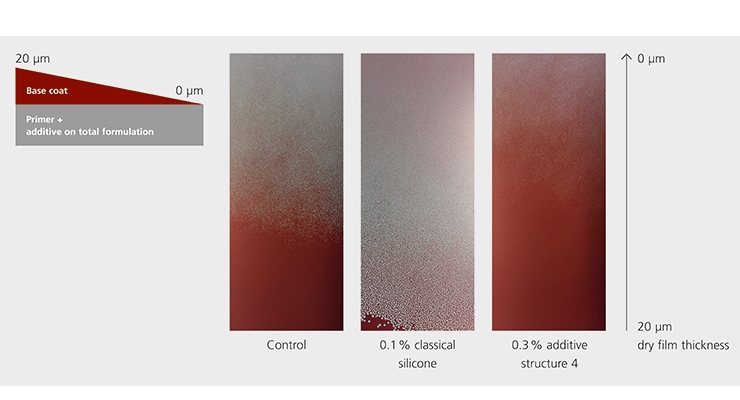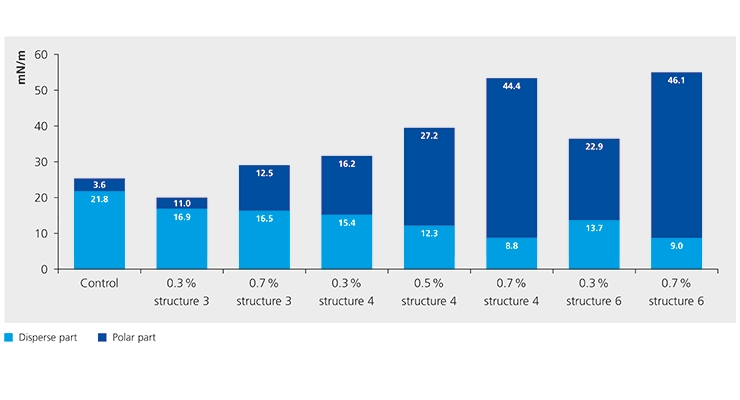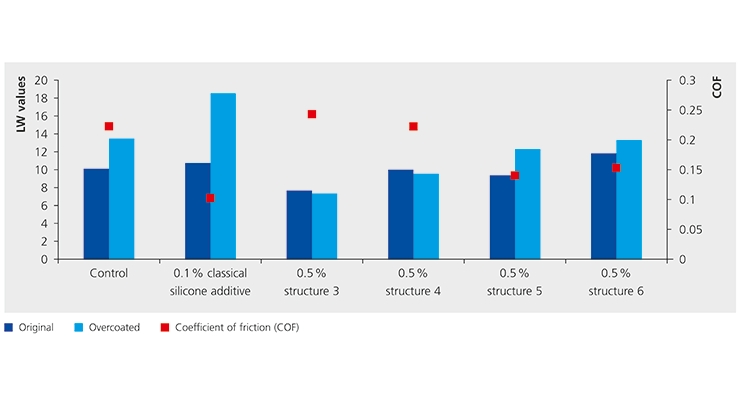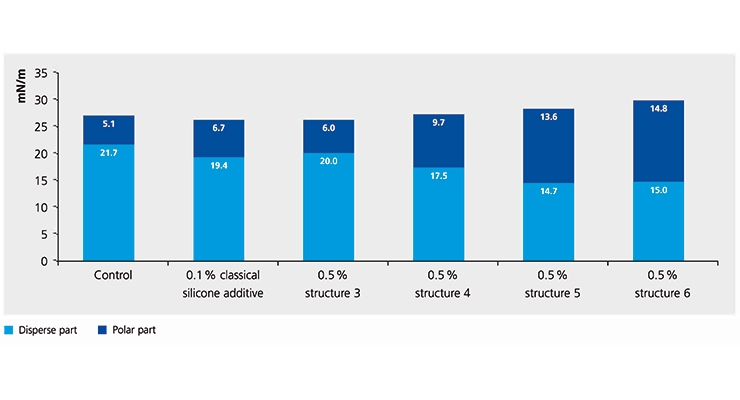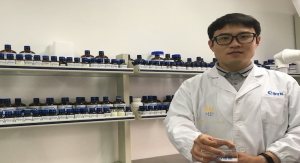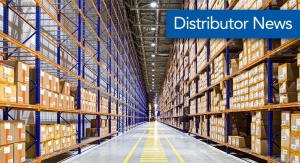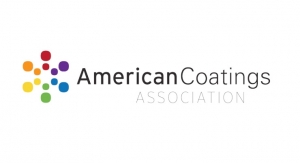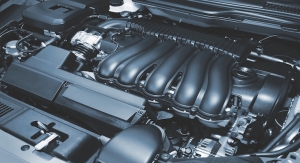Dr. Horst M. Sulzbach, Mark Heekeren, Dr. Marc Eberhardt, Dr. Guillaume W. Jaunky, BYK-Chemie GmbH, Wesel, Germany06.04.18
Modern waterborne and conventional solvent-based coatings face a number of technical and commercial challenges. Additives are increasingly important for enabling the coating formulator to reach these ever-growing demands and advance the technology. Wetting, leveling, slip, recoatability or easy-to-clean properties are strongly influenced by surface-active additives. These surface additives migrate toward the coating/air or coating/substrate interface and tailor the surface or interface behavior. A unique possibility of building up multi-layer coating systems is to increase the surface energy of an underlying coating using hydrophilic additives, which positively affects the wetting of the subsequent coating layer.
Ways to Achieve Better Wetting
The classic approach to improve substrate wetting is to use an additive, which reduces the surface tension of the coating to be applied. Fluorinated surfactants and silicone surfactants are the most effective substances in this group of additives. Even in small quantities, they reduce the static surface tension of the coating and favor the spreading. For many years, coating formulators primarily used these tools to improve substrate wetting and also wetting over primers, basecoats, middle coats etc. This is still the first approach to improve the wetting of cured coating films, but the method has many disadvantages in multi-layer coatings. First, a low surface tension of the coatings is not ideal for achieving the best possible leveling. Secondly, it is necessary to consider the wetting process of the different layers between each other and with a given substrate. The adjustment of the surface tension with additives in multilayer coatings can be problematic if the underlying layers have relatively low surface energies. Last but not least, many of the wetting additives may cause a serious foam stabilization issue especially when using fluorinated surfactants.
In most coating formulations, the surface tension is reduced using organically modified polysiloxanes (classical silicone additives), in which, for example, the polysiloxane forms the backbone and the polyether the end or side chains. The silicone additives improve the wetting of substrates or underlying coatings (primers) and enhance the anti-crater performance. At the same time, however, the more active silicone additives in particular reduce the surface energy of cured coatings.
A new and unique opportunity for multi-layer coating systems is to not use a substrate wetting additive, but to raise the surface energy of the underlying coating (or primer), so that no conventional wetting additive is needed for the subsequent coating. For the first time, a new generation of hydrophilic additives has been developed, which – unlike other surface additives – is able to raise the surface energy of the cured coating film substantially. This results in perfect wetting of the subsequent coating and good intercoat adhesion when recoated.
Structure is Decisive
Leveling additives are essential constituents of many coating systems, and they fulfil an important role: they help minimize differences in the surface tension during the drying and curing process, thus creating a smooth surface appearance.
The first generation of leveling additives are homopolymers or copolymers of standard alkyl acrylates or alkyl methacrylates. A (meth)acrylate monomer is a small molecule containing a polymerizable double bond that binds covalently to other monomers to build a polymer chain. The structure of the (co)polymer chain is linear. Leveling additives based on polyacrylates have a relatively low glass transition temperature and are slightly incompatible with the coating matrix. The polymer chains are, therefore, located on the surface of the coating and keep the surface tension constant during the curing process. The chemical structure and polarity can be varied within extensive limits through the selection of suitable monomers and polymerization conditions. Setting the degree of polymerization (n) determines the molecular weight, and the polarity is managed by varying the R2 groups (Figure 1a). This first generation of leveling additives has been state-of-the-art for decades, and has produced many useful products that are successful on the market.
The development of the next generation of leveling additives provided additional benefits by influencing the surface tension/energy of liquid/cured coatings. These comb copolymer structures are technically accessible through the use of special, functionalized components, the so-called “macromonomers”. An acrylate macromonomer is essentially an assembly of pre-polymerized monomers modified to enable it to act as a monomer through the addition of one polymerizable double bond. The free-radical copolymerization of standard acrylate monomers and macromonomers advantageously provides comb-shaped copolymers (Figure 1b). Another way of designing comb copolymers is to use the “grafting onto” method: i.e., a reactive macromonomer is linked to a preformed polymeric backbone bearing complementary reactive groups.
Purpose-designed comb copolymers with appropriate combinations of monomer /macromonomer sequence distributions and of pendant functional groups can be used to control the properties of additives. Using this macromonomer technology, the properties of additives can be enhanced through targeted design, for example, by introducing hydrophobic or hydrophilic macromonomers into the polymeric backbone. In this way, we designed specific acrylic comb copolymers as surface-modifying additives to dictate the surface energy of coatings, e.g., rendering their surfaces hydrophobic or hydrophilic. Silicone-modified polyacrylates have a very flexible molecular design and, therefore, coating properties such as hydrophobicity, oleophobicity, anti-cratering performance and controlled slip can be adjusted very precisely. Using polyether-modified polyacrylates, properties such as hydrophilicity, antistatic, antifogging, improved overcoatability and adhesion can be targeted. In the following discussion, we essentially focus on hydrophilic additives.
The silicone macromonomers have a unique molecular structure, and are produced using a controlled polymerization process. It is, therefore, possible to tailor the chemical and physical characteristics of these components - and of the additives based thereon - to the respective coating systems. This also opened the door to a second generation of structure 2 leveling additives (Figure 2), with, in part, surprising characteristics that at first appear contradictory. For example, the surface tension of the liquid coating material is greatly reduced, without negative effects on the surface energy of the cured coating.1 A major reduction in the surface tension of the liquid coating material is normally achieved through the use of classical silicones. Nevertheless, these silicone additives significantly affect the surface energy of the cured coating because of their non-polar silicone chain. The reduction in surface energy makes overcoating more difficult.
A further member of this second generation of leveling additives can be used to increase the surface energy of the cured coating. This modern form of structure 3 leveling additives is achieved through the development of polyether macromer-modified structures that are also highly branched. The resulting hydrophilic additives improve the leveling, and bring about an increase in the surface energy of the cured coating. The result is a significantly improved and thus easier overcoatability.2
The next generation of leveling additives has been developed in order to combine the said beneficial characteristics in a single product. This third generation uses the full spectrum of macromonomer technology, thus making it possible to achieve unique structures and properties. The combination of hydrophilic polyether and hydrophobic silicone macromonomers has resulted in the development of leveling additives that offer improved overcoatability and leveling, and also anti-cratering performance. The third and next generation therefore represents a milestone in the history of leveling additives.
To better illustrate the effects of the new additives, the following chart compares the various additive structures of the three generations and their properties from an application perspective.
Silicone Macromonomers Create the Difference
The next generation additives were tested in a conventional 1K-OEM primer based on polyester and melamine binders, and compared with classical silicone additives or standard acrylate-based leveling additives. The results are summarized in Figure 3.
A measurement of the surface tension of the liquid coatings using the du Noüy ring method shows that only additives with longer silicone chains (classical silicone additive and structure 2 leveling additives containing silicone macromonomers) can achieve a significant reduction in the surface tension.
Structures with shorter silicone chains such as structure 4 as well as the two silicone-free additives (structure 1 and structure 3) show no, or only very minor, effects on the surface tension reduction.
While the classical silicone additive reduces the surface tension, the silicone macromer-based leveling additives of structures 5 and 6 do not reduce surface tension substantially, despite silicone in their structures. The polyether macromer-based leveling additive 3, which is very compatible in the primer, hardly orientates itself towards the coating/air interface, and thus only slightly increases the surface energy of the cured coating. However, as soon as the structures that contain polyether macromonomer also combine silicone macromonomer as in structures 4, 5 and 6, they orientate themselves more strongly towards the interface - a fact that is clearly reflected in the higher surface energies measured.
The influence of the surface energy on the wetting of the subsequent layer can be seen very clearly if the primer surfacer is overcoated with a waterborne red basecoat (Figure 4).
In this comparative test, the “unmodified” primer (control) could be wetted by the red basecoat in a continuous layer by using ~15 μm dry film thickness, but, by using only 0.3 % structure 4 additive in the primer, this thickness could be reduced to just ~ 8 μm. The coating with the classical silicone additive in the primer presents significantly poorer wetting. This example shows how the increase in the surface energy through use of the structure 4 hydrophilic additive in the primer has a positive effect on the spreading of the subsequent red basecoat.
Increased Effectiveness at Lower Curing Temperatures
Due to the good compatibility of the polyether macromer, the structure 3 additive showed insufficient surface orientation in both conventional and waterborne systems.
In waterborne systems, which are cured at room temperature or at low temperature, the additive with structure 3 often does not orient sufficiently at the surface to achieve a substantial increase in surface energy. As can be seen in Figure 5, a considerably greater effect can be achieved in these systems with the combined silicone macromonomer and polyether macromonomer structures 4 and 6. The fact that the additive with structure 6 causes a greater increase in the surface energy than the additive with structure 4 despite longer silicone chains, appears contradictory. This is due to the additives becoming increasingly more incompatible the longer the silicone chain, and thus favoring their orientation toward the coating-air interface.
An Eye on the Waviness
The new structures are also interesting in hydro topcoat systems. The wetting of the underlying coating in these systems is usually produced by means of classical silicone additives. These additives are normally used to make the coating crater-resistant as well and create a smooth surface. In fact, these silicones cause a reduction in the surface energy. This does not, however, constitute a problem with single coating. Nevertheless, if the topcoat has to be overcoated again for the purpose of repair or optical appearance (for example two-color finish), the lower surface energy causes not only poorer wetting but also poorer leveling. While the additive with the shorter silicone chain (structure 4) showed no reduction in coefficient of friction (no increase of surface slip), the additives with longer silicone chains (structures 5 and 6) caused a significant surface slip increase (Figure 6).
The trend of an increase in the overall surface energy can also be demonstrated with the topcoat. The polar part of the total surface clearly increases with the length of the silicone chains due to better surface orientation of the structure 5 and 6 additives (Figure 7).
The Future is Macromer
The “classic” approach to improve wetting over a substrate or underlying coating surface is to reduce the surface tension of the subsequent coatings. This method is widely used, but has some limitations. The “new” approach is to use the next-generation hydrophilic additives in the underlying coatings. The technology is recommended in principally all types of multilayer coating systems, where the hydrophilic additive will segregate to the surface of a primer, thus improving wettability by the subsequent coating layer. The latest generation of hydrophilic additives are multi-functional and can combine properties such as anti-cratering behavior and increased slip to the hydrophilic effects. C
References
1 Nagel, C.; Heekeren, M.; Frank, A. New silicone structures: new hybrid structure yields versatile surface-modifying polymers. Eur. Ctgs. J. 2010, 4, 32-34, 36, 38-39.
2 Heekeren, M.; Bessel, M.; Jaunky, G. Primed for improvement; hydrophilic additive enhances leveling and intercoat adhesion. Eur. Ctgs. J. 2014, 10, 27-31.
Ways to Achieve Better Wetting
The classic approach to improve substrate wetting is to use an additive, which reduces the surface tension of the coating to be applied. Fluorinated surfactants and silicone surfactants are the most effective substances in this group of additives. Even in small quantities, they reduce the static surface tension of the coating and favor the spreading. For many years, coating formulators primarily used these tools to improve substrate wetting and also wetting over primers, basecoats, middle coats etc. This is still the first approach to improve the wetting of cured coating films, but the method has many disadvantages in multi-layer coatings. First, a low surface tension of the coatings is not ideal for achieving the best possible leveling. Secondly, it is necessary to consider the wetting process of the different layers between each other and with a given substrate. The adjustment of the surface tension with additives in multilayer coatings can be problematic if the underlying layers have relatively low surface energies. Last but not least, many of the wetting additives may cause a serious foam stabilization issue especially when using fluorinated surfactants.
In most coating formulations, the surface tension is reduced using organically modified polysiloxanes (classical silicone additives), in which, for example, the polysiloxane forms the backbone and the polyether the end or side chains. The silicone additives improve the wetting of substrates or underlying coatings (primers) and enhance the anti-crater performance. At the same time, however, the more active silicone additives in particular reduce the surface energy of cured coatings.
A new and unique opportunity for multi-layer coating systems is to not use a substrate wetting additive, but to raise the surface energy of the underlying coating (or primer), so that no conventional wetting additive is needed for the subsequent coating. For the first time, a new generation of hydrophilic additives has been developed, which – unlike other surface additives – is able to raise the surface energy of the cured coating film substantially. This results in perfect wetting of the subsequent coating and good intercoat adhesion when recoated.
Structure is Decisive
Leveling additives are essential constituents of many coating systems, and they fulfil an important role: they help minimize differences in the surface tension during the drying and curing process, thus creating a smooth surface appearance.
The first generation of leveling additives are homopolymers or copolymers of standard alkyl acrylates or alkyl methacrylates. A (meth)acrylate monomer is a small molecule containing a polymerizable double bond that binds covalently to other monomers to build a polymer chain. The structure of the (co)polymer chain is linear. Leveling additives based on polyacrylates have a relatively low glass transition temperature and are slightly incompatible with the coating matrix. The polymer chains are, therefore, located on the surface of the coating and keep the surface tension constant during the curing process. The chemical structure and polarity can be varied within extensive limits through the selection of suitable monomers and polymerization conditions. Setting the degree of polymerization (n) determines the molecular weight, and the polarity is managed by varying the R2 groups (Figure 1a). This first generation of leveling additives has been state-of-the-art for decades, and has produced many useful products that are successful on the market.
The development of the next generation of leveling additives provided additional benefits by influencing the surface tension/energy of liquid/cured coatings. These comb copolymer structures are technically accessible through the use of special, functionalized components, the so-called “macromonomers”. An acrylate macromonomer is essentially an assembly of pre-polymerized monomers modified to enable it to act as a monomer through the addition of one polymerizable double bond. The free-radical copolymerization of standard acrylate monomers and macromonomers advantageously provides comb-shaped copolymers (Figure 1b). Another way of designing comb copolymers is to use the “grafting onto” method: i.e., a reactive macromonomer is linked to a preformed polymeric backbone bearing complementary reactive groups.
Purpose-designed comb copolymers with appropriate combinations of monomer /macromonomer sequence distributions and of pendant functional groups can be used to control the properties of additives. Using this macromonomer technology, the properties of additives can be enhanced through targeted design, for example, by introducing hydrophobic or hydrophilic macromonomers into the polymeric backbone. In this way, we designed specific acrylic comb copolymers as surface-modifying additives to dictate the surface energy of coatings, e.g., rendering their surfaces hydrophobic or hydrophilic. Silicone-modified polyacrylates have a very flexible molecular design and, therefore, coating properties such as hydrophobicity, oleophobicity, anti-cratering performance and controlled slip can be adjusted very precisely. Using polyether-modified polyacrylates, properties such as hydrophilicity, antistatic, antifogging, improved overcoatability and adhesion can be targeted. In the following discussion, we essentially focus on hydrophilic additives.
The silicone macromonomers have a unique molecular structure, and are produced using a controlled polymerization process. It is, therefore, possible to tailor the chemical and physical characteristics of these components - and of the additives based thereon - to the respective coating systems. This also opened the door to a second generation of structure 2 leveling additives (Figure 2), with, in part, surprising characteristics that at first appear contradictory. For example, the surface tension of the liquid coating material is greatly reduced, without negative effects on the surface energy of the cured coating.1 A major reduction in the surface tension of the liquid coating material is normally achieved through the use of classical silicones. Nevertheless, these silicone additives significantly affect the surface energy of the cured coating because of their non-polar silicone chain. The reduction in surface energy makes overcoating more difficult.
A further member of this second generation of leveling additives can be used to increase the surface energy of the cured coating. This modern form of structure 3 leveling additives is achieved through the development of polyether macromer-modified structures that are also highly branched. The resulting hydrophilic additives improve the leveling, and bring about an increase in the surface energy of the cured coating. The result is a significantly improved and thus easier overcoatability.2
The next generation of leveling additives has been developed in order to combine the said beneficial characteristics in a single product. This third generation uses the full spectrum of macromonomer technology, thus making it possible to achieve unique structures and properties. The combination of hydrophilic polyether and hydrophobic silicone macromonomers has resulted in the development of leveling additives that offer improved overcoatability and leveling, and also anti-cratering performance. The third and next generation therefore represents a milestone in the history of leveling additives.
To better illustrate the effects of the new additives, the following chart compares the various additive structures of the three generations and their properties from an application perspective.
Silicone Macromonomers Create the Difference
The next generation additives were tested in a conventional 1K-OEM primer based on polyester and melamine binders, and compared with classical silicone additives or standard acrylate-based leveling additives. The results are summarized in Figure 3.
A measurement of the surface tension of the liquid coatings using the du Noüy ring method shows that only additives with longer silicone chains (classical silicone additive and structure 2 leveling additives containing silicone macromonomers) can achieve a significant reduction in the surface tension.
Structures with shorter silicone chains such as structure 4 as well as the two silicone-free additives (structure 1 and structure 3) show no, or only very minor, effects on the surface tension reduction.
While the classical silicone additive reduces the surface tension, the silicone macromer-based leveling additives of structures 5 and 6 do not reduce surface tension substantially, despite silicone in their structures. The polyether macromer-based leveling additive 3, which is very compatible in the primer, hardly orientates itself towards the coating/air interface, and thus only slightly increases the surface energy of the cured coating. However, as soon as the structures that contain polyether macromonomer also combine silicone macromonomer as in structures 4, 5 and 6, they orientate themselves more strongly towards the interface - a fact that is clearly reflected in the higher surface energies measured.
The influence of the surface energy on the wetting of the subsequent layer can be seen very clearly if the primer surfacer is overcoated with a waterborne red basecoat (Figure 4).
In this comparative test, the “unmodified” primer (control) could be wetted by the red basecoat in a continuous layer by using ~15 μm dry film thickness, but, by using only 0.3 % structure 4 additive in the primer, this thickness could be reduced to just ~ 8 μm. The coating with the classical silicone additive in the primer presents significantly poorer wetting. This example shows how the increase in the surface energy through use of the structure 4 hydrophilic additive in the primer has a positive effect on the spreading of the subsequent red basecoat.
Increased Effectiveness at Lower Curing Temperatures
Due to the good compatibility of the polyether macromer, the structure 3 additive showed insufficient surface orientation in both conventional and waterborne systems.
In waterborne systems, which are cured at room temperature or at low temperature, the additive with structure 3 often does not orient sufficiently at the surface to achieve a substantial increase in surface energy. As can be seen in Figure 5, a considerably greater effect can be achieved in these systems with the combined silicone macromonomer and polyether macromonomer structures 4 and 6. The fact that the additive with structure 6 causes a greater increase in the surface energy than the additive with structure 4 despite longer silicone chains, appears contradictory. This is due to the additives becoming increasingly more incompatible the longer the silicone chain, and thus favoring their orientation toward the coating-air interface.
An Eye on the Waviness
The new structures are also interesting in hydro topcoat systems. The wetting of the underlying coating in these systems is usually produced by means of classical silicone additives. These additives are normally used to make the coating crater-resistant as well and create a smooth surface. In fact, these silicones cause a reduction in the surface energy. This does not, however, constitute a problem with single coating. Nevertheless, if the topcoat has to be overcoated again for the purpose of repair or optical appearance (for example two-color finish), the lower surface energy causes not only poorer wetting but also poorer leveling. While the additive with the shorter silicone chain (structure 4) showed no reduction in coefficient of friction (no increase of surface slip), the additives with longer silicone chains (structures 5 and 6) caused a significant surface slip increase (Figure 6).
The trend of an increase in the overall surface energy can also be demonstrated with the topcoat. The polar part of the total surface clearly increases with the length of the silicone chains due to better surface orientation of the structure 5 and 6 additives (Figure 7).
The Future is Macromer
The “classic” approach to improve wetting over a substrate or underlying coating surface is to reduce the surface tension of the subsequent coatings. This method is widely used, but has some limitations. The “new” approach is to use the next-generation hydrophilic additives in the underlying coatings. The technology is recommended in principally all types of multilayer coating systems, where the hydrophilic additive will segregate to the surface of a primer, thus improving wettability by the subsequent coating layer. The latest generation of hydrophilic additives are multi-functional and can combine properties such as anti-cratering behavior and increased slip to the hydrophilic effects. C
References
1 Nagel, C.; Heekeren, M.; Frank, A. New silicone structures: new hybrid structure yields versatile surface-modifying polymers. Eur. Ctgs. J. 2010, 4, 32-34, 36, 38-39.
2 Heekeren, M.; Bessel, M.; Jaunky, G. Primed for improvement; hydrophilic additive enhances leveling and intercoat adhesion. Eur. Ctgs. J. 2014, 10, 27-31.

